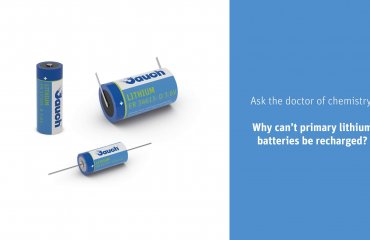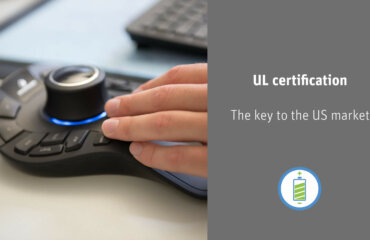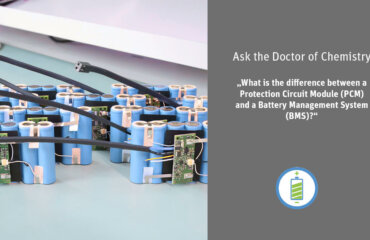
Lithium batteries and battery cells are classified as dangerous goods class 9, just like liquid nitrogen, for example. The legal requirements for safe transport are correspondingly high.
Whether by rail, road or air, the eligibility of lithium cell or battery shipments is regulated by the transport test 38.3 of the United Nations. A shipment is only permitted if the following eight individual tests are passed.
1) Altitude Simulation
This test simulates the environmental conditions prevailing in the cargo hold of an aircraft at an altitude of up to 15,000 meters. The battery is exposed to an extremely low air pressure of 11.6 kilopascal for a total of six hours. The test is passed if:
- the battery shows no loss of mass
- the overpressure valve of the battery remains closed
- the battery housing is free of cracks or leaks,
- the voltage level of the battery differs from the initial value by a maximum of 10% after completion of the test.
2) Thermal Test
If the altitude simulation has been successfully completed, the next step is to check the behavior of the lithium battery in case of strong temperature fluctuations. This stresses the battery seals and internal electrical connections. The batteries are initially stored for at least six hours at a surrounding temperature of 72 degrees Celsius. The temperature is then lowered to -40 degrees Celsius for a further six hours. This test procedure, for which Jauch uses a specially designed thermal shock chamber, must be carried out over 10 complete cycles. Finally, the batteries are stored at room temperature for at least another twelve hours. The test is passed when all the criteria mentioned under 1) have been met.
3) Vibration Test
The third part of the UN 38.3 transport test puts the battery in a vibration generator, where the battery is subjected to frequencies between 7 and 200 Hertz. The test is designed for a total of three hours and simulates the typical jerking in the hold of a truck while driving. The criteria mentioned under 1) also apply in this case.
4) Impact Test
Just like the vibration test, the impact test also serves to prevent possible damage to the battery by rough transport. Depending on the size of the lithium battery, impacts of 150G/6mS or 50G/11mS affect the housing. Just as in the vibration test, the criteria listed under 1) apply here as well.
5) External Short Circuit Test
For this test, the battery is first heated from the outside to a temperature of 57 degrees Celsius before an external short-circuit is caused. As a result, the battery temperature rises, but must not exceed 170 degrees Celsius. Once the battery has cooled down to 57 degrees again, the short-circuit condition must remain for another 60 minutes. The test is only passed if neither flames, cracks nor other damage to the battery housing are detected for up to six hours afterwards.
6) Impact and Crush Test
This test is carried out at cell level and simulates external damage to the cells that can occur because of a strong impact, such as a traffic accident. For this purpose, depending on the cell type and shape, a stamp with a precisely defined size and press depth is pressed into the cells. Damaged in this way, an internal short-circuit can occur in the cell. The test is passed if, as with the external short-circuit test, the housing temperature does not exceed 170 degrees Celsius at any time and no signs of cracks or similar appear on the housing up to six hours after the test.
7) Overcharging Test
The UN 38.3 transport test prescribes an overcharge test for all rechargeable lithium batteries. For 24 hours, twice the maximum permissible charging current is applied to the battery. The battery must then be stored in a secure area for seven days. No damage may occur during this period for the battery to pass.
8) Fast Discharge Test
The final test is also carried out at cell level. The cell is subjected to a discharge current exceeding the permitted maximum. This procedure is repeated several times. As with overcharging, rapid discharge must not damage the battery in any way in order to successfully pass this test.
Safe Transport of Lithium Batteries
According to UN 38.3, a battery may not be shipped by rail, road or air until it has passed each of these eight test procedures. From January 2020 forward, all shippers also have to provide a test summary, proving that batteries have passed the UN 38.3 test.
Jauch can carry out all eight UN 38.3 test procedures in its own test center. As a customer, this means that all batteries that you purchase from Jauch are certified according to UN 38.3. The entire design process is expedited as no third party is required for proper UN 38.3 certification.


 Deutsch
Deutsch 




Good day
Where a battery manufacturer test cells, they do it with A-Grade cells. B-Grade or faulty cells will not pass, so one assumes that they will not be allowed to ship such cells with the UN38.3 certification.
Many companies in South Africa received B Grade cells from suppliers in China, all with the same MSDS and UN38.3 certifications they received in testing A-Grade cells
Question.
1)Are there restrictions on suppliers as to what cells they are allowed to ship. For example, a B Grade cell fails the internal resistance test. It will three heat up faster than A Grade cell if placed in a discharge test.
2) If they are not allowed, is there a body where one will be able to report such a company
3) Are there penalties in place if one can prove that they sending substandard cell with a UN 38.3 certification
Thanks for the time in this regard
Hi Mr. le Grange
I’m sorry to hear that some companies don’t seem to comply to UN 38.3. However, I cannot really help you with your questions I’m afraid. As battery manufacturer, we’re simply not allowed to offer legal advice. So, maybe you should speak to lawyer instead.
Best Regards
Pascal